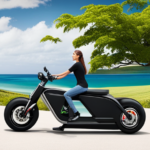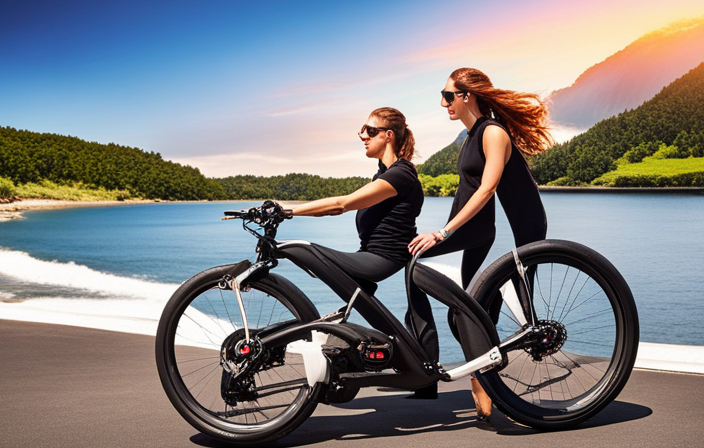Did you know that the average electric bike can travel up to 50 miles on a single charge?
However, what happens when your electric bike runs out of charge halfway through your ride?
In this article, I will explore the range of electric bikes, signs that your battery is running low, and what to do when you find yourself with a dead battery.
With some helpful tips and proper battery management, you can continue to enjoy the benefits of electric biking without any worries.
Key Takeaways
- Public transportation systems and carpooling offer alternative transportation options in case your electric bike runs out of charge.
- Proper battery management, including regular maintenance and avoiding overcharging, can maximize efficiency and extend the lifespan of the battery.
- Optimizing battery usage by riding at a consistent speed, avoiding sudden accelerations or decelerations, and planning efficient routes can help conserve battery power.
- Charging the battery fully before each ride is crucial to ensure optimal performance and provide a longer riding range.
Understanding the Range of Your Electric Bike
Understanding the range of your electric bike is crucial when it comes to knowing how far you can go before needing to recharge. Range optimization and battery capacity play a significant role in determining the distance your electric bike can travel on a single charge. Range optimization involves maximizing the efficiency of your electric bike to achieve the longest possible distance. Factors such as terrain, rider weight, and speed can affect the range of your electric bike.
Additionally, the battery capacity determines how much power your electric bike can store and ultimately how far it can take you. By understanding these concepts, you can plan your rides accordingly and avoid running out of charge unexpectedly.
Now, let’s delve into the signs that your battery is running low.
Signs that Your Battery is Running Low
When you notice signs that your battery’s charge is running low, it’s important to take action. Extending battery life is crucial for maximizing the performance and longevity of your electric bike.
One of the signs of battery degradation is a decrease in the range of your bike. If you find that your electric bike is not traveling as far as it used to on a single charge, it may be an indication that your battery is running low.
Another sign is a decrease in the overall power and speed of your bike. If you notice a significant drop in performance, it could be a sign that your battery is nearing depletion.
Understanding these signs can help you plan your rides accordingly and prevent your electric bike from running out of charge unexpectedly.
Now, let’s explore what to do when your electric bike runs out of charge.
What to Do When Your Electric Bike Runs Out of Charge
If you find yourself in a situation where your e-bike’s battery has completely depleted, there are a few steps you can take to get back on the road.
First, you can look for emergency charging options such as public charging stations or friends who may have a compatible charger. If those options are not available, you can try troubleshooting common battery issues.
Check for loose connections, ensure the battery is securely attached, and inspect the charger for any signs of damage. If none of these steps work, it might be time to consider contacting the manufacturer or a professional for assistance.
Taking these steps can help you get your electric bike back up and running.
Now, let’s move on to some tips for preventing your electric bike from running out of charge.
Tips for Preventing Your Electric Bike from Running Out of Charge
To prevent running out of charge on your e-bike, make sure to plan your routes accordingly and be aware of the distance you can travel on a single charge. This will help you avoid being stranded in the middle of nowhere.
Additionally, here are some tips to help you prevent your electric bike from running out of charge:
-
Look for electric bike charging stations along your planned route. Knowing where these stations are located can provide you with peace of mind, knowing that you can recharge your bike if needed.
-
Optimize your battery life by avoiding extreme temperatures. High heat or cold can negatively impact the performance of your battery. Keep your bike stored in a moderate temperature environment when not in use.
-
Take advantage of battery life optimization strategies, such as using pedal-assist mode when possible, avoiding excessive hills, and maintaining a steady speed.
By following these tips, you can ensure that you have a worry-free ride on your electric bike.
In the next section, we will discuss how to extend the battery life of your electric bike without compromising its performance.
How to Extend the Battery Life of Your Electric Bike
You can maximize the lifespan of your e-bike battery by implementing certain strategies. Effective charging techniques play a crucial role in optimizing battery performance.
It is recommended to charge your electric bike battery after each use, rather than letting it completely drain before recharging. This helps maintain a consistent charge level and prevents deep discharges, which can significantly reduce battery life.
Additionally, using the correct charger and charging your battery at the recommended voltage and current levels can help prevent overcharging or undercharging, both of which can negatively impact battery performance.
By following these effective charging techniques, you can extend the battery life of your electric bike and ensure that it performs optimally for a longer period of time.
Moving on to the impact of weather conditions on battery life…
The Impact of Weather Conditions on Battery Life
Now that we’ve discussed how to extend the battery life of your electric bike, let’s delve into the impact of weather conditions on battery life.
It is essential to understand how temperature and altitude can affect the performance and range of your electric bike’s battery.
-
Impact of temperature on electric bike battery performance:
- Extreme cold temperatures can decrease battery efficiency and overall range.
- High heat can also reduce battery performance and potentially shorten its lifespan.
-
Effect of altitude on electric bike battery range:
- Riding at higher altitudes can have a significant impact on the range of your electric bike.
- The lower air density at higher altitudes can cause the motor to work harder and drain the battery faster.
Regular maintenance and taking care of your battery’s health is vital to ensure optimal performance and longevity.
With that in mind, let’s explore the importance of regular maintenance and battery health in the next section.
Importance of Regular Maintenance and Battery Health
Taking care of your battery and performing regular maintenance is crucial for optimal performance and longevity. Battery maintenance involves a combination of charging techniques and monitoring battery health.
First, it is important to charge your electric bike using the manufacturer’s recommended charging method. This typically involves using the provided charger and avoiding overcharging or undercharging the battery. Regularly checking the battery’s voltage and ensuring it is within the recommended range is also important for its overall health.
Additionally, keeping the battery clean and protected from extreme temperatures can help prolong its lifespan. By following these battery maintenance practices, you can ensure that your electric bike’s battery remains in good condition and performs at its best.
Understanding the cost of recharging your electric bike is the next step in maximizing your electric bike experience.
Understanding the Cost of Recharging Your Electric Bike
Understanding the cost of recharging an electric bike can help you plan your budget effectively. When considering the cost comparison between recharging your electric bike and refueling a traditional gasoline-powered vehicle, the savings can be significant.
Electric bike charging typically costs a fraction of what you would spend on gas for a car. Additionally, with the increasing availability of charging infrastructure, recharging your electric bike is becoming more convenient and accessible. Many cities now have public charging stations, making it easier to find a place to recharge your bike on the go. Furthermore, advancements in technology have led to faster charging times, reducing the overall cost and time spent on recharging.
With these factors in mind, it is important to explore alternative transportation options in case of emergency, such as public transportation or carpooling, to ensure you have a backup plan if your electric bike runs out of charge.
Exploring Alternative Transportation Options in Case of Emergency
In case of an emergency, it’s important to have alternative transportation options available, such as public transportation or carpooling. When your electric bike runs out of charge, you can consider utilizing these alternative fuel options.
Public transportation systems, like buses or trains, are a reliable choice for commuting when your electric bike is no longer operational. They offer a convenient and efficient way to travel without the need for personal vehicles.
Additionally, carpooling with friends or colleagues can be a cost-effective and environmentally-friendly solution. By sharing a ride, you not only reduce the number of vehicles on the road but also save money on fuel expenses.
These alternative transportation options ensure that you can still get around even if your electric bike is out of charge.
Transitioning to the subsequent section about enjoying the benefits of electric biking with proper battery management, it’s essential to understand how to optimize battery usage and ensure uninterrupted rides.
Conclusion: Enjoying the Benefits of Electric Biking with Proper Battery Management
To fully enjoy the benefits of electric biking, it’s crucial to ensure proper battery management. Battery maintenance is key to maximizing efficiency and getting the most out of your electric bike. Regularly checking and maintaining your battery can extend its lifespan and keep it running smoothly.
One important aspect of battery management is charging. It’s essential to charge your battery fully before each ride and avoid overcharging. Overcharging can lead to decreased battery performance and overall lifespan. Additionally, storing your battery at the proper temperature can help maintain its efficiency.
Another important consideration is how you use your electric bike. Riding at a consistent speed and avoiding sudden accelerations or decelerations can help conserve battery power. Planning your routes to maximize efficiency, such as avoiding steep inclines or opting for bike lanes, can also help extend your battery life.
By following these battery management practices, you can fully enjoy the benefits of electric biking and ensure your battery is operating at its optimal level.
Frequently Asked Questions
Can I push my electric bike when it runs out of charge?
Yes, you can push your electric bike when it runs out of charge. It becomes an alternative mode of transportation. Pushing it manually is a simple and effective way to get to your destination without the need for power.
How long does it take to recharge an electric bike battery?
Recharging an electric bike battery varies depending on its size. Smaller batteries can take around 2-3 hours, while larger ones may take 4-6 hours. It’s important to consider battery size when comparing recharge times.
Is it possible to replace the battery of an electric bike?
Yes, it is possible to replace the battery of an electric bike. The lifespan of a battery depends on factors like usage and maintenance. When the battery reaches the end of its lifespan, it can be replaced with a new one.
Can I ride my electric bike in the rain without damaging the battery?
Yes, you can ride your electric bike in the rain without damaging the battery. However, it is important to take some maintenance tips into consideration, such as drying the bike afterwards and avoiding deep water puddles.
Are there any safety concerns when charging an electric bike battery?
When charging an electric bike battery, it is important to take charging precautions and prioritize battery maintenance. Proper care and attention will ensure the longevity and safety of the battery.
Conclusion
In conclusion, managing the battery life of your electric bike is crucial to ensure a smooth and enjoyable riding experience.
By understanding the range of your bike, recognizing the signs of a low battery, and taking preventive measures, you can avoid the inconvenience of running out of charge.
Regular maintenance and proper battery health are key to extending the lifespan of your electric bike.
Remember, ‘a stitch in time saves nine,’ so take care of your battery to avoid any unexpected hiccups on your electric biking adventures.
Happy riding!
















